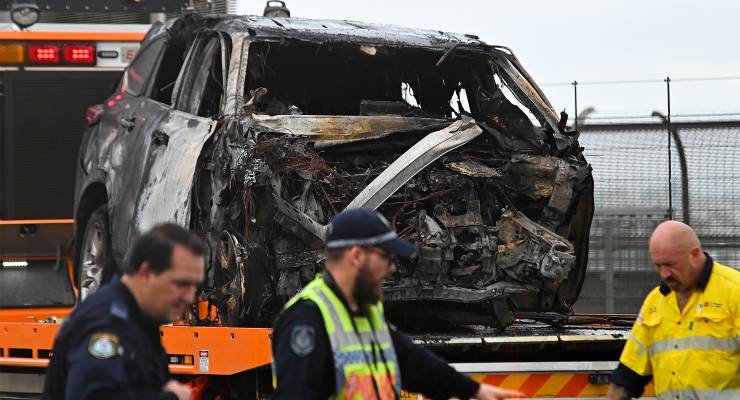
Where’s our progress? In the past decade, Australia’s famous leadership on road deaths has fizzled out. It looks like we got down to about 1000 deaths a year and collectively said, well, that’s enough.
Note that this chart includes data for all of 2023. To obtain an annual figure, I tripled the deaths by the end of April. Hopefully we don’t get that high, but unfortunately it is likely to be a conservative projection as usually the first four months of the year have slightly fewer deaths than the next two four-month periods.
What’s going on? Why didn’t things improve much more in 2020 when half the country was in lockdown, and why is the line going up post-lockdown? What about all the new safety tech in modern cars — does it really help?
Is this just what the road toll will look like when we are at the safety frontier but we have a growing population? Or can it be attributed to the rampant inflation of vehicle sizes, such as the popular American-size trucks?
We can’t answer all these questions in this article, but we can get some clues. Breaking down the data by road user type, we can see that cycling deaths are just as high now as two decades ago. That’s got something to do with more people cycling, of course.
Motorcycling defies the pattern of every other road user group, getting more dangerous, while pedestrians are dying in smaller numbers than a decade ago.
That’s certainly a hint that the problem isn’t just about vulnerable road users. It’s not RAMs rolling over pedestrians that explains the lack of progress. Meanwhile, single-vehicle crashes are rising compared with multiple-vehicle crashes, so we can’t necessarily say the lack of progress in the road toll is due to Hiluxes crashing into Corollas and killing the smaller car’s occupants.
The rise in fatal single-vehicle accidents over the period might suggest that the bigger vehicles in our fleet aren’t keeping us safer. It is certainly the case that they are more likely to tip over and need more stopping distance. If you buy a massive ute thinking it will make you safe, that’s likely to be a false assumption.
Age group
By age group, the risk has shifted. Young hoons are no longer as much of a menace to themselves as they once were. Indeed, young people are a much smaller percentage of fatal crashes than before. But don’t be misled by the chart; they are still most at risk given that the age bracket is much narrower.
Pedestrians
Pedestrian deaths are down in the past few years, but there is a clear pattern for them: the time of year matters. As this chart below shows, May is the worst time of year for pedestrian deaths. If you’re driving home today, take extra care.
But why is this so? Is it because the days are darker but the weather has not yet got so bad as to make walking unpleasant?
If that were the case you’d expect the situation to be worse in southern states where the days get shorter more dramatically when winter starts. I checked the stats by state, and there’s some evidence of that, but NSW is much worse than Victoria, which is not what you’d expect.
But then I remembered the big problem with Sydney: its longitude. The capital of NSW perches out on the extreme eastern edge of its time zone, leading to very early dusks. The sun will set in Sydney at 5pm today, meaning a lot of people leaving work are getting home in the gloaming — or indeed total darkness. The next two months will be full of even earlier sunsets, including the winter solstice when the sun sets at 4.53pm.
Could the extra pedestrian deaths be centred on the commute home? As the next chart shows, the answer is yes.
The intersection of mild weather and early sunsets means lots of pedestrians on busy roads in low-light conditions, leading to lots of deaths. And remember that for every pedestrian fatality, there are lots of people permanently maimed: broken bones, lost limbs, traumatic brain injuries. They aren’t even in these stats.
Melbourne has shorter May days than Sydney because of its more southerly latitude. But the light is lost in the morning — Melbourne enjoys more evening light than Sydney, because it is relatively westerly in the time zone. The extra evening light means students and workers have more chance to get home before dark.
In Melbourne today the sun will set at 5.17pm today and 5.07pm on the solstice. That slight difference probably explains why the May effect is less pronounced in Melbourne, combined of course with the weather that deters pedestrians earlier in the year.
This data hints at possible improvements that could lower the road toll: better street lighting in areas that are dangerous in the early evening. It also highlights a bigger point: the progress in reducing the road toll that we used to obtain is still possible — we just need to choose to pursue it.








Possibly also:
* boomers having midlife crisis and buying motorbikes too powerful for them
* gig economy moped riders adding to the toll
* how many single vehicle accidents are suicides
* tired tradies having to drive long distances to and from their workplace
Playing around with phones has had exponential growth in the last few years. Virtually every trip I take I see cars weaving around on the road and can clearly see many people just not concentrating on driving. Expect the toll to get worse while drivers keep being distracted with these damn gadgets.
I believe the replacement of visible police traffic presence with speed cameras has an impact. Nothing sets someone straight more effectively than an in person ticket. As others have mentioned there is little to no effort to improve driver skill and road awareness levels. All these factors add to the road toll.
I’m always astounded at how many vehicle fatalities cite not wearing a seatbelt as a cause of death. Surely in 2023 these fatalities should be put into a separate Darwin Awards column?
Further progress on the road toll will only be possible if simplistic sloganeering can fix it, since that’s all the authorities seem to be good for.
I’m willing to bet a big part of the problem is the pathetic standard of driving that’s typical these days.
We’ve got ridiculous congestion here in Melbourne, made so much worse by all the fwits who are too lazy to stay in their lane in a turn, or even indicate the lane change, meaning people turning right have to wait for people turning left onto the same road even when there’s a lane for each.
Then there are all the deadshts who let big gaps grow in front of them, for reasons unknowable, in traffic moving well under the speed limit.
This sort of idiotic behaviour is apparently totally fine, because there’s nothing in the way of PSAs promoting traffic flow and attempting to reduce the stupidity. The roads being full of incompetents is a-ok.
So on the one hand you have all these terrible drivers getting no feedback that they’re terrible, and on the other you’ve got people who remember what it was like when people could still drive, losing their minds in frustration at this orgy of stupidity.
Seems pretty damn unsafe to me.
Oh, and if you bought one of those pedestrian-munching, small-car-crushing behemoths, here’s me hoping hell is a thing.
The stats look like the olden days drivers were crap compared to now. Especially considering how few cars there were on the roads back in the golden days of our yooth! I remember it well: no traffic lights, cops on point duty in the rush hour, driving home totally pissed head out the window to follow the two white lines. The six o’clock swill. No indicators, no radio, no aircon, the smell of the Holden’s dash in the sun in the afternoon at the beach. No belts, abs, gps, the UBD open on the knee. Drivers all happy, they owned a car! The ease of the test, if any at all. No radar, no cameras. Don’t start me.
I’m talking about the 90s, not the 60s
Surprisingly drastic you are correct but you do not know it. Also Kimmo is correct.
Driving is an intuitive skill. Unless you are driving say a V8 supercar around Bathurst the drive does not apply all of their attention to driving. If required to do so children would not be allowed to be passengers. And yes Kimmo’s descriptors are apt in many cases and were not as significant a number of years ago.
So what has changed. I used to drive down a straight road with gravel down each side. The road today is now a narrow lane that requires one to move into the left lane to avoid RH turners and a hundred metres ahead move into the RH lane to avoid LH turners and so on. Intersections look like a picasso painting. Lines everywhere. Then there is all the other lanes, turning, stopping etc. Intersections used to have one red and one green light. Some now have multiple. There is a jungle out there.
It is just not as simple as driving down the road, stopping at the red etc like in the past.
I could do a comlete article on this topic.
Spot on.
Forgot to mention the dipshts who think they have any business holding up the traffic behind them to make a lane change.
You missed your turnoff, that’s nobody else’s fault. Take the next turnoff.
Toot these r-soles and they act like they’re in the right. Need to fit rocket launchers to my vehicle, in the absence of any police enforcement of decency.
In the US, pedestrian deaths are at a 40-year high – maybe the trend towards monster trucks is having an impact there, and is yet to fully arrive here